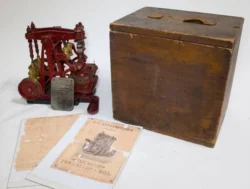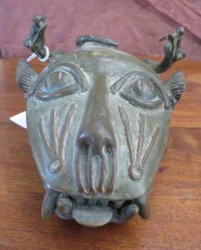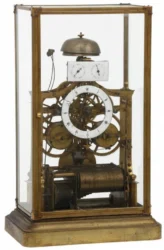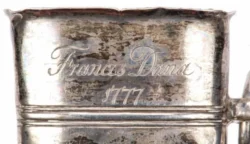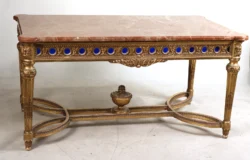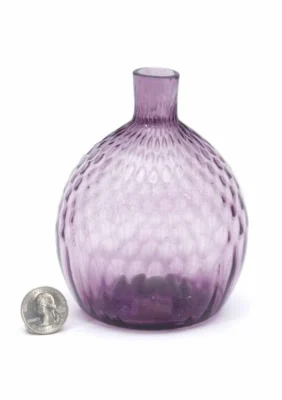
Press Release (ePRNews.com) - WOODSTOCK, Conn. - Apr 01, 2017 (UTC) - A pattern molded covered sugar bowl and an early pattern molded pocket bottle, both manufactured by Stiegel’s American Flint Glass Manufactory in Manheim, Pennsylvania sometime between 1763 and 1774, combined to sell for nearly $20,000 in an online-only auction (Premier Auction 146) held March 6-15 by Norman C. Heckler & Company.
The brilliant cobalt blue sugar bowl featured a 16-diamond pattern and a cylindrical bowl flared to the rim, with matching cover having an applied swirled rib finial. The glass quality and clarity were superb, with a strong mold impression. The light-to-medium lavender pocket bottle was a masterpiece of early American glassware, with its plump form and ogival pattern above flutes.
The sugar bowl was the auction’s top lot, selling for $10,530. “Which is significant, since sugar bowls and other tableware got regular use and weren’t put up on a shelf, like a bottle or a flask,” said company owner Norman Heckler. “That they survive intact for so many years is remarkable in itself, but to be presented in like-new condition, like this sugar bowl was, is simply amazing.”
Mr. Heckler added, “Maybe it’s finally time tableware will get the respect it deserves, and not take a back seat to bottles and flasks. We had many fine examples in the auction, including salt bowls, utility jars and creamers. Most did very well. We also saw high prices paid for the better examples of blown glass, the ones that were very important. Overall, the sale went quite well.”
The auction was an eclectic mix of merchandise, one that included early glass, bottles, flasks, paperweights, bitters, soda and mineral water bottles, freeblown and pressed glass, whiskeys, medicines, pattern molded glass, utilities and inkwells. Headlining the auction was the lifetime collection of Ed and Sherry Losacano.
The early pattern molded pocket bottle sold for $9,360, but it wasn’t the only such flask in the auction. Another one, maker unknown but probably manufactured in the Midwestern United States between 1820 and 1830, bluish aquamarine in color, sold for a very reasonable $1,755. The 5-inch-tall flask, ribbed and swirled to the right, with 16 ribs, boasted truly brilliant glass.
Following are additional highlights from the auction. All prices quoted include a 17 percent buyer’s premium.
The runner-up top lot was a “Freiot’s Renovator” medicine bottle, probably made by Albany Glass Works (N.Y.), circa 1847-1850. The rare, oval form, forest green bottle was only recently discovered during a house renovation in New York. It sold for $9,945. Another rarity, a “Haddock & Sons” soda water bottle, made in America circa 1820-1840, in a brilliant olive yellow and showing a plump torpedo form, possibly the finest example known, realized $4,095.
An “Old English” spaced millefiori paperweight, most likely made in England between 1920 and 1930, cylindrical in form with a flat base and having multicolor decorations on smoke green and colorless ground, fetched $8,775; while a pattern molded master salt bowl with 17 ribs slightly swirled to the left, probably made by Mantua (Ohio) Glass Works circa 1820-1830, having a double ogee bowl with drawn circular foot, light to medium lavender in color, reached $2,925.
A “For Pike’s Peak” historical flask with an image of a man shooting a deer, attributed to the Ravenna (Ohio) Glass Works, circa 1860-1870, colored a brilliant golden amber with an olive tone and boasting a wonderful whittled surface, realized $8,190; and an “Eagle – Cornucopia” historical flask made by Keene (N.H.) Marlboro Street Glassworks, in a never-before-seen brilliant olive yellow and having an interesting fold of glass at the base of the neck, made $2,574.
A “Bininger’s” clock form figural whiskey bottle (“19 Broad St., New York”), made in America between 1850 and 1860, a rare aquamarine in color and in fine condition, with bold embossing, sold for $4,680; while an “E. G. Booz’s Old Cabin Whiskey” figural bottle made by Whitney Glass Works (Glassboro, N.J.), circa 1860-1880, medium reddish amber fading to yellow in the corners and having a rectangular modified cabin form, 7 ¾ inches tall, hit $4,388.
A fancy ink bottle made in America between 1840 and 1860, conical in form with a drape pattern and label panel, medium cobalt blue in color, just 2 ½ inches tall, went for $4,972; and a Pitkin type inkwell, probably made by Pitkin Glass Works (Manchester, Connecticut, circa 1783-1830), bright yellowish olive and inverted conical in form, in overall fine condition, finished at $2,691.
A handsome, bulbous-bodied brilliant aquamarine freeblown pitcher, probably made by a South New Jersey glasshouse between 1830 and 1850, having gadrooned decoration flaring to the rim, made $3,802; and a freeblown utility jar produced in New England circa 1800-1840, cylindrical in shape and medium olive amber in color, with a tooled wide flared mouth, commanded $3,510.
An aquamarine freeblown creamer, likely made by a Zanesville, Ohio glasshouse between 1830 and 1850, having a bucket form body flaring to the rim with an applied hollow ear form handle, hammered for $2,925. Another possible Zanesville piece, a medium yellow amber freeblown footed bowl, cylindrical in shape and with an appealing, unusual form, sold for $1,521.
Norman C. Heckler & Company’s next auction (Select Auction 148) will be an absentee auction that will open Monday, May 8th and close on Wednesday, May 17th. Watch website for details.
Norman C. Heckler & Company is always accepting quality consignments for future sales. To inquire about consigning a single piece or an entire collection, you may call them at (860) 974-1634, or e-mail them at info@hecklerauction.com. To learn more about Norman C. Heckler & Company and the firm’s calendar of upcoming auctions, please visit www.hecklerauction.com.
Source : Norman C. Heckler & Company
